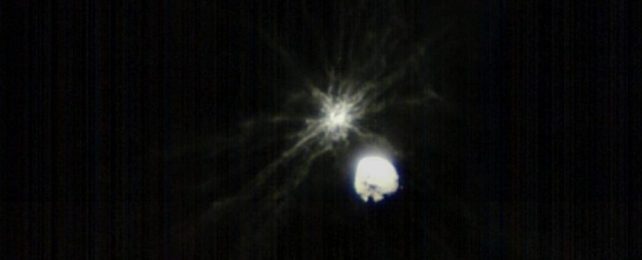Yesterday, humanity achieved a new and amazing first, 11 million kilometers (6.8 million miles) from home.
After years of planning, NASA's Double Asteroid Redirection Test (DART) finally slammed into a moonlet, Dimorphos, orbiting an asteroid, Didymos, in our first ever attempt to redirect the path of a significantly sized cosmic object.
The images of the looming asteroid provided a front-seat view to the moment of impact, but left us wondering what the collision might have looked like to a nearby observer.
Now we have an idea.
To monitor the impact and the effects on Dimorphos in the immediate aftermath, DART carried an Italian Space Agency (ASI) cubesat called Light Italian CubeSat for Imaging of Asteroids (LICIAcube), equipped with two optical cameras, LEIA and LUKE. Prior to impact, the cubesat was deployed, and was thus able to capture the entire spectacular event.
Here are the first images taken by #LICIACube of #DARTmission impact on asteroid #Dimorphos.
— LICIACube (@LICIACube) September 27, 2022
Now weeks and months of hard work are now starting for scientists and technicians involved in this mission, so stay tuned because we will have a lot to tell! pic.twitter.com/kVz1WmcsL7
In the images, the large bright object is the asteroid, Didymos. The delicate, spidering lines are plumes of dust erupting from Dimorphos as a result of the impact. The images should reveal how much of the moonlet was destroyed by the impact, as well as information about its composition.
This information will help scientists then design future asteroid redirection missions, refining the technology based on these results.
"Now the science can start," said planetary scientist Katarina Miljkovic of Curtin University in Australia.
After all, slamming a spacecraft into an asteroid was not just for funsies. The mission was designed to test our ability to redirect any asteroids we detect on a collision course with Earth in the future – something that in the past, has proven extremely hazardous to any life that happened to be hanging around.
The next phase involves looking out for changes in the movement in the impacted body. This is why Dimorphos was chosen, in fact. At around 160 meters (525 feet) across, the asteroid orbits the 780 meter-wide Didymos roughly once every 11.9 hours in a wobbly dance.
In a single object zipping around the Sun all on its lonesome, we might struggle to measure such a tiny change using ground-based telescopes. An asteroid trapped in a well-known orbital period, however, should make for an easier target to study.
"From this one impact event, we can learn more about the mechanics of impacts into small bodies, momentum transfer and the ability to use artificial impactors to nudge asteroids out of their orbits," says Miljkovic.
"This hasn't been done before… We needed a large-scale experiment, to get a validation against the real data. This is to ensure that should Earth ever encounter a dangerous asteroid hurtling towards us, we would know what to do."
